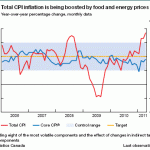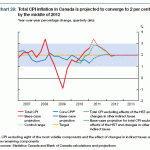I have spent the better part of the day doing some screening and research on microcap companies (generally those with market capitalizations of under CAD$50 million). I discarded most of the energy and mineral-type firms as these firms are generally impossible for third-parties to get any sort of edge on.
Finding good microcap companies reminds me of the process of mining for bitcoins – you can spend hours (and days) doing it, but still end up with nothing. That was pretty close to what the last half day of my life feels like.
When doing some intermediate analysis on 9 companies, one managed to clear the necessary thresholds for “interestingness” on my watchlist, although this was not a case that screamed at me as a company that will see 5-fold increases in its equity prices. It would be considered a value play. I set a price target that was roughly 20% under what it was currently trading as this would be a valuation that I would be interested in doing some more extensive due diligence for a potential purchase (although it would be a small allocation if it ever got to that point). I will receive an email if it reaches this price threshold.
However, there were two interesting “discards” that I will share.
The first company is Audiotech Healthcare (TSX: AUD), which operates a few hearing clinics in more remote areas of BC, Alberta and the USA. They are family run and family-controlled and stable and profitable. Their balance sheet is in OK shape, with sufficient cash on hand to cover upcoming debt maturities and otherwise not polluted with massive goodwill (indeed, none). Management is relatively respectful of shareholder value (likely due to its significant economic interest in the company) and related party transactions are at an acceptable level (the worst of it is a dead real estate lease in Calgary which will likely be off the books soon). Valuation is relatively cheap, with recent business performance in the last fiscal year producing $347,000 in free cash flow on a (undiluted) market capitalization of $2.38 million. They are ripe to go private or to be consolidated by a larger player.
Unfortunately, their shares are completely illiquid. With $10,000 in volume traded over the past 30 days, a single trader can probably take the stock price up 50% in a day. Hence, this company is in the “interesting but not practical” list of investment candidates.
The next company that I had to do a double-take on is a little more strange. Spot Coffee (Canada) (TSX: SPP) operates coffee franchises, not too dissimilar from Blenz, Waves, Second Cup and Starbucks, in locations in Western New York state, Toronto and one location in Florida. The only difference is that they appear to be larger scale than the typical Starbucks chains and they also serve slightly more complex food offerings.
What is particularly strange is that when you read the management/director biographies, you ask yourself “What the heck are these people getting into this business for?”. I will post the following from their most recent management information circular and let you come to your own conclusions:

The company itself seems to be financed mostly with equity, with the company raising equity capital through private offerings as the need arises. The last private placement was at 10 cents per share for $500,000 and warrants to purchase shares at 15 cents a piece expiring in 3 years. The current market value is $8.6 million and 13.5 cents per share. Operationally they are losing money, but this is due to the lack of economies of scale associated with having such a geographically dispersed operation and relatively low numbers of operating coffee shops.
Gross profit margins have been improving – the most recent quarter being 73%, which is a good improvement over the previous year. Presumably if they manage to scale up their sales in other locations they can actually start to make money, but I haven’t bothered doing the breakeven calculations. This is investing in an industry that is already well established.
Although I won’t be touching the equity on this company, something makes me suspect that this company might be the recipient of some “hype valuation” if they continue opening more stores, sort of akin to Caribou Coffee (Nasdaq: CBOU).
That concludes my investment research for the day – little to show for it.




